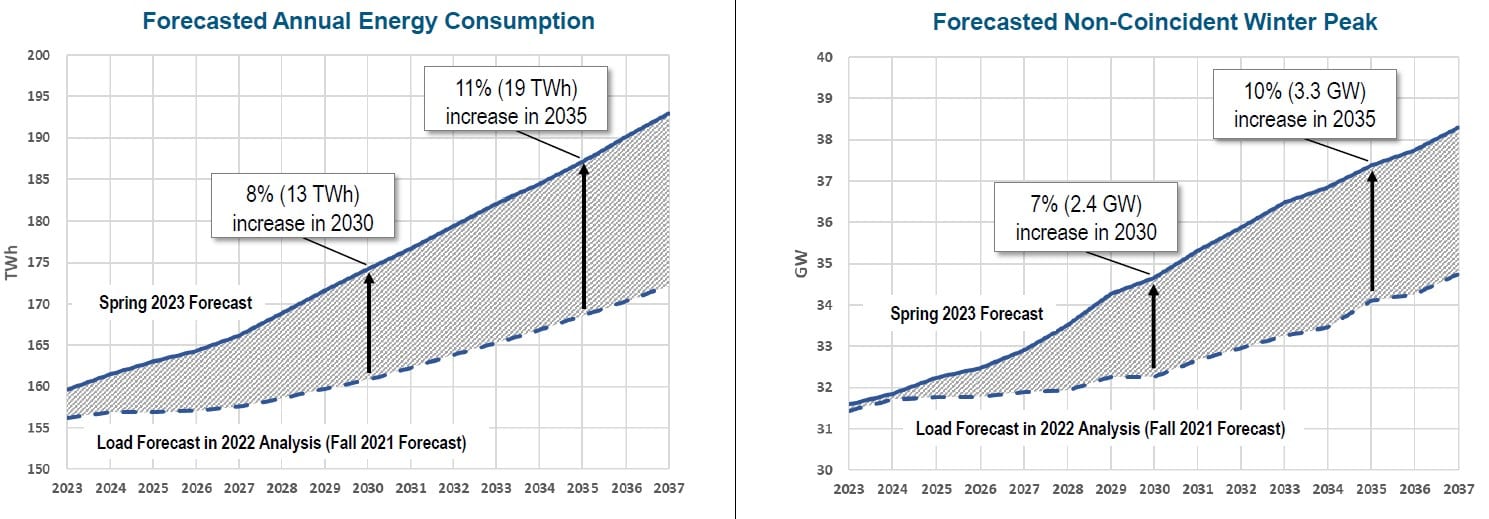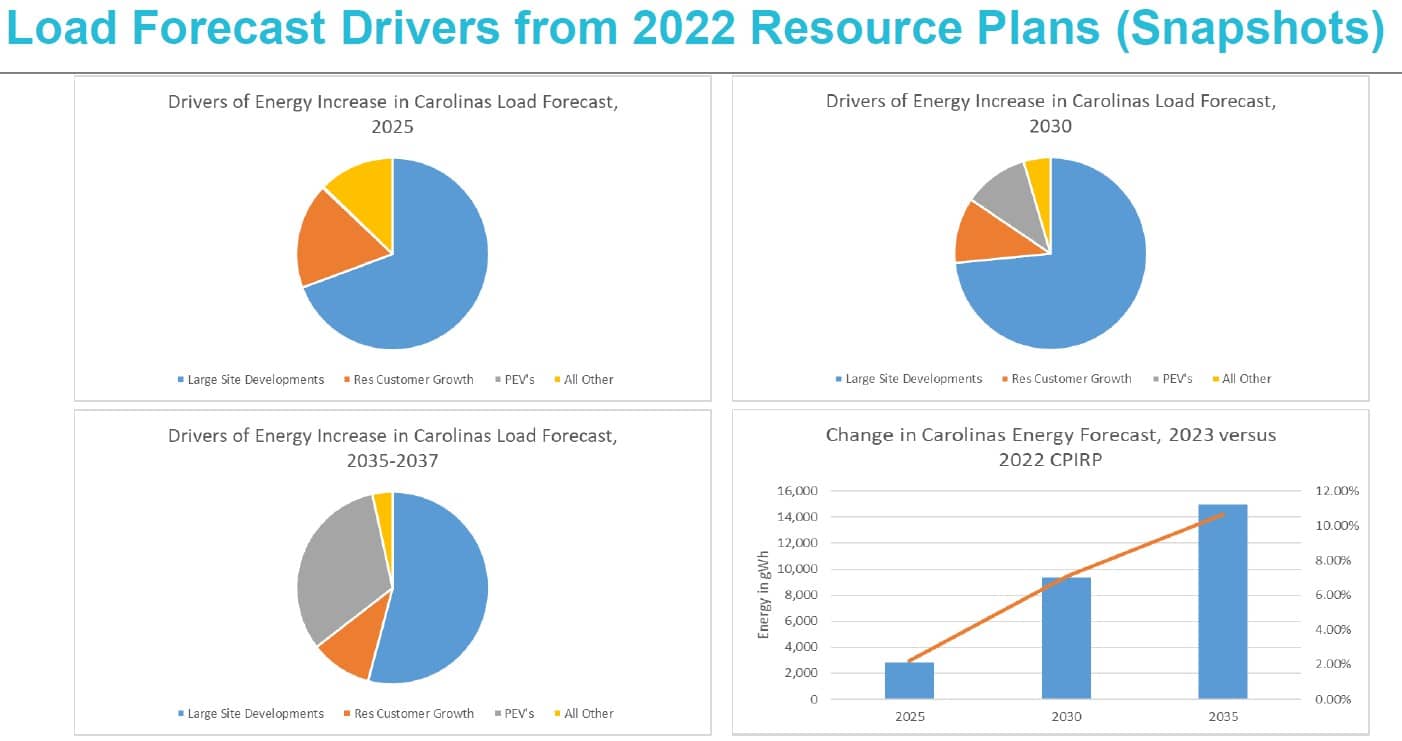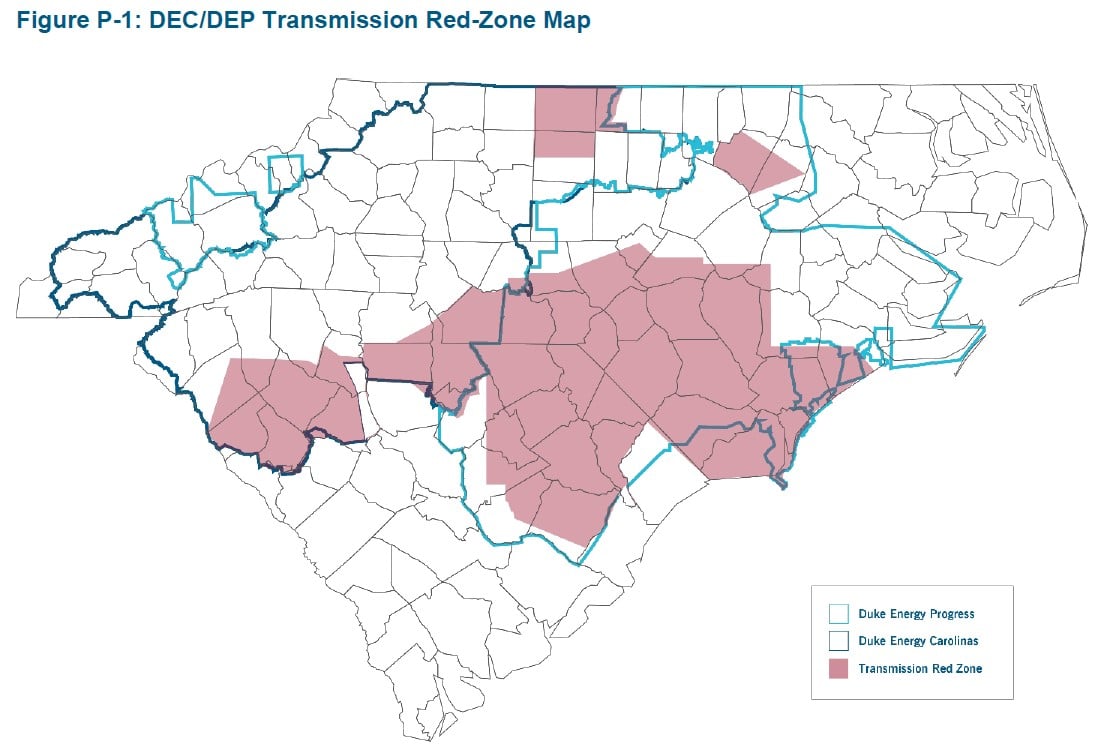Duke Energy, one of the most high-profile electric utility companies in the country, is gearing up to start a process with potential to significantly impact carbon reduction in the Southeast.
Maggie Shober | August 3, 2023 | North Carolina, South Carolina, UtilitiesDuke will file a joint resource plan for both of its operating companies in North and South Carolina later this month.
First, Duke will file an Integrated Resource Plan (IRP) in South Carolina on August 15 (Dockets 2023-8-E and 2023-10-E). Second, a resource plan that meets the requirements of a state Carbon Plan and IRP (CPIRP) will be filed in North Carolina (Docket E-100, Sub 190) on August 17, with additional testimony to be filed on September 1.
While this seems like a lot to keep track of, Duke will actually be filing the same resource plan in both states. Since Duke operates two utilities, Duke Energy Carolinas (DEC) and Duke Energy Progress (DEP), in both North and South Carolina, the filing requirements allow it to file the same plan and even match up the filing dates relatively closely.
However, that second filing in North Carolina will start the clock on the 180 days North Carolina intervenors have to file their own testimony. Thus, by my calculations, I expect intervenor testimony on the 2024 CPIRP to be due February 28, 2024. With a bit more certainty on the schedule, and less than a month until the filing itself, let’s review what we know so far about what to expect in Duke’s CPIRP.
Most of this information is derived from five presentations Duke gave to stakeholders between February and June. The slides and videos of those presentations are available on the website Duke has set up for the CPIRP. I won’t go through all of it, only what I think is most relevant at this point, and what I think has most substantially changed since the NCUC released its order on the Carbon Plan at the end of 2022.
Duke Projecting Higher Load
Duke is expecting higher load and winter peaks starting this year (2023) when compared to projections in the previous Carbon Plan. It also expects both annual load and annual winter peaks to grow faster than its previous projections. The largest driver of this increase is “Large Site Developments,” particularly between now and 2030. So, these are either new or expanding large industrial, manufacturing, commercial, or institutional customers.

In addition to higher winter peak forecasts, Duke increased its planning reserve margin, or the percent of capacity it plans to have on its system above the projected peak, from 17% to 22%. The drivers of that increase include a decrease in the assistance from neighbor utilities, an increase in the load forecast error, and an increase in unit outage and winter capacity risk. This is one area where we hope to learn a lot more about Duke’s method and assumptions behind this reserve margin increase. Combined with the increased winter peak load forecast, Duke could use this to try to justify proposals to continue operating coal plants or build even more new gas plants.
Large Customers Driving Increased Load
The largest driver of this increase is “Large Site Developments,” particularly between now and 2030. These are new or expanding large industrial, manufacturing, commercial, or institutional customers. While personal electric vehicles (EVs) show up as a driver in 2030, they do not increase the load forecast significantly above the previous forecast until the 2035-2037 timeframe. The impact of electrification of medium- and heavy-duty vehicles (M/HD) is not broken out as a separate driver of load growth, so at this point we can assume Duke’s load forecast method has minimal to moderate M/HD electrification built in, despite evidence that there are major stakes to M/HD electrification in the Carolinas, driven by the business case of electrifying these vehicles as well as manufacturer targets, federal incentives, state goals, and corporate policies.

Duke Increases EV Projections
Duke’s latest forecast of EVs in its territory is similar in the next few years, then begins to significantly diverge from its previous forecast in about 2027. The higher forecast after 2027 is driven, at least in part, by incentives from the Bipartisan Infrastructure Law (BIL), Inflation Reduction Act (IRA) and other policies; updated data on current vehicle registrations; and updated battery cost projections. In these preliminary assumptions Duke is assuming just over 900,000 EVs of all duties in its service territory by 2030. Compare this to North Carolina’s goal of 1.25 million registered zero-emission vehicles by 2030 to achieve 50-52% emission reductions form 2005 levels by 2030. While Duke’s utilities do not cover all of North Carolina, personal vehicles and fleets in South Carolina are also poised to electrify, so Duke’s forecast could end up being low relative to actual consumer and fleet behavior.

What else isn’t clear about this EV forecast is whether or not it includes the cooperative and municipal utilities that purchase power from Duke. Since several of these utilities serve long stretches of interstate, where vehicles will be charging, it is important that Duke accurately forecast the coming electrification and break down silos between generation, transmission, and distribution planning to ensure electricity can make it to where vehicles will need it to charge.
Filings to Include Update to Transmission Planning Process
In a separate process from the Carbon Plan/IRP stakeholder presentations, members of the North Carolina Transmission Planning Collaborative (NCTPC), of which Duke Energy is a member along with North Carolina-based municipal and cooperative utilities, announced plans to update the transmission planning process this fall and that more information about those process updates can be expected in the IRP and Carbon Plan filings in August. One change is that the collaborative name will change, likely to “Carolinas Planning Collaborative” since it is open to all utilities that operate within the transmission system footprints of DEC and DEP, so both North and South Carolina. Most importantly, it is likely that this new process will include a look for “Multi-value Strategic Transmission Projects,” to be studied at least once every 3 years. See slides 39-46 of the June Transmission Advisory Group (TAG) meeting presentation for more on what we know so far about these process changes.

The NCTPC has been particularly relevant to Duke’s generation resource planning decisions in recent years as the transmission “red zone” was one of the hottest topics of debate in the lead up to the 2022 Carbon Plan. The final NC Carbon Plan order from the NCUC directed Duke to both complete the red zone transmission projects and improve its transmission planning process. Those red zone transmission projects were included in the 2022 transmission plan, and are underway. Process changes will be filed in October.
Duke Modeling Minimum on Energy Efficiency
In its presentation to stakeholders in February, Duke says it will model two energy efficiency scenarios: 1% and 1.5% of eligible retail load. As a reminder, Duke’s non-residential customers can opt-out of paying for energy efficiency funding, so Duke excludes its sales to those customers from energy efficiency calculations. Since a majority of non-residential load has opted-out, this can skew the numbers quite a bit. While we pushed for the Commission to require Duke to use total retail sales, the final Carbon Plan order from the NCUC approved Duke’s target of 1% of eligible sales and set an “aspirational” target of 1.5% of eligible sales. Contrast this with the guidance the South Carolina PSC gave another utility, Dominion, to study energy efficiency levels up to 2% in its 2023 IRP. While the SC PSC did not give that same guidance to Duke, it is clear from what we know through the stakeholder process so far that Duke is setting up for a CPIRP filing that does the bare minimum on energy efficiency.
Duke Still Limiting Renewables
Duke’s solar cost assumptions, presented in March, are still subject to change before Duke completes its modeling and files its resource plan. The capital costs in particular are much higher than those included in the National Renewable Energy Laboratory’s (NREL) latest Annual Technology Baseline (ATB) forecast, which came out in July. Duke estimates capital costs for utility-scale solar will be $1,800/kW-AC in 2023 and over $1,300/kW-AC in 2030, whereas NREL’s ATB estimates overnight capital costs in the range of $1,300/kW-AC in 2023 and $1,000/kW-AC in 2030 across multiple scenarios. That’s a significant difference, and one we hope Duke has already corrected in its modeling assumptions. We will have to wait for the filing to know for sure.

Furthermore, as stated in the slides from the June 13 stakeholder session, Duke plans to limit annual solar additions to 1,350 MW/year across both its utilities, with specific limits of 525 MW/year in DEC and 825 MW/year in DEP. But Florida Power & Light (FPL), which is about the size of Duke’s combined utilities in the Carolinas, just announced that it has connected nearly 1,200 MW of solar just in the first half of 2023. So, in addition to potentially higher cost assumptions for solar, Duke is also potentially constraining the model in how much solar it can add in a given year.
Both offshore wind and onshore wind are assumed unavailable until 2031, meaning Duke does not think they could get a project operational until that year.
Different Jurisdictions Require Different Gas Forecasts
There are two categories of fuel price forecasts used in resource planning: commodity-based and fundamentals-based. A commodity-based forecast is based on current prices in a forward market, meaning essentially a price a utility could lock in today for a given timeframe. A fundamentals-based forecast is one in which a supply-demand model is used to forecast prices into the future. In its 2020 IRP order, the SC PSC required Duke to use a gas price forecast that is 18 months of commodity prices and an 18-month transition to a fundamentals-based forecast based on at least two fundamental-based forecasts. In the 2022 North Carolina Carbon Plan, Duke used 5 years of a commodity-based forecast and a 3-year transition from market-based to fundamentals-based. In its 2023 method, Duke says it will use the 5+3 year method from the 2022 Carbon Plan, use multiple fundamental-based forecasts, and include the 18-month-18-month method from the 2020 SC PSC order in its sensitivities.
Still More Questions than Answers
While Duke provided some preliminary information across its presentations to stakeholders in February through June, it can still change anything and everything that was presented before finalizing and filing its resource plan with regulators in both Carolinas. Electric utility IRPs are complex and only becoming moreso as we electrify new sectors and transition electricity generation to be carbon-free. IRPs are also becoming increasingly important as the Southeast experiences more frequent and severe extreme weather events. If we don’t take meaningful steps in this resource plan to make our grid more resilient, less reliant on fossil fuels, and ready for electrification, we will lose valuable time on all of those fronts.
The filings this August are the beginning of a process that will run for many months in South Carolina and likely through the end of next year in North Carolina. In the end, regulators in both states must weigh cost, reliability, and many other potential impacts before making a final decision on the plan that will guide one of the country’s biggest electric utilities for the next few years.
There is a reason resource planning is done every 1-3 years: so sectoral and economy-wide changes can be incorporated. But since the process now takes 1-2 years in many jurisdictions, it can feel perpetual. We have had it relatively light since the last Commission order at the end of 2022 (everyone but Duke’s team, they are always working on the next resource plan), but it’s about to heat up again this August.
Break’s over, let’s get to work.